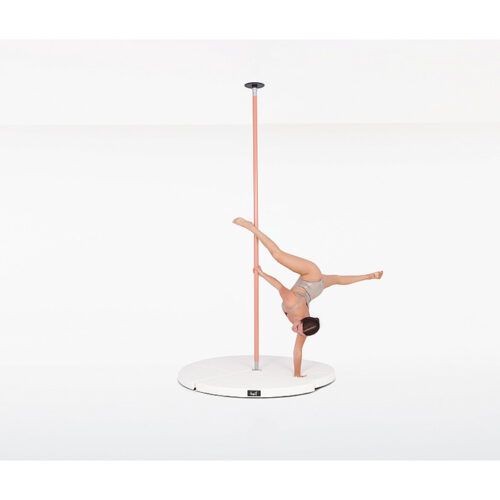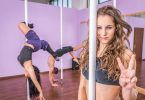Is pole dancing inappropriate? It’s a question rooted in stereotypes and misunderstandings, but the truth is far from what many might think. Pole dancing is an empowering, athletic, and artistic activity that transcends the misconceptions tied to its origins. In this article, we’ll explore why pole dancing deserves respect and recognition as a legitimate sport and art form.
Is Pole Dancing Inappropriate? Let’s Address the Misconceptions
Misconception #1: It’s Only for Strippers
Let’s set the record straight: Pole dancing is an art form, a sport, and a fitness regimen that welcomes individuals from all walks of life. Pole dancing studios across the globe have created a safe and empowering environment where people can explore their physical abilities, build strength, and boost self-confidence. It’s not about who you are; it’s about embracing your inner strength and expressing yourself through graceful movements.
Misconception #2: It’s Inherently Sexual
We’ve all seen those movie scenes where a sultry character sensually gyrates around a pole in dimly lit clubs. However, this portrayal doesn’t accurately represent pole dancing as a whole. Pole dance is also a form of artistic expression and physical fitness. While there are routines that incorporate sensual movements, they are just one facet of the diverse world of pole dancing.
Imagine a pole dancer gracefully defying gravity with acrobatic moves, or executing spins and poses with incredible strength and flexibility. The athleticism displayed in pole dancing is awe-inspiring, and it’s crucial to recognize that sensuality is just one dimension of this multifaceted discipline.
Misconception #3: Only Women Pole Dance
The stereotype that only women participate in pole dancing is a misconception that needs to be debunked. Pole dancing is a gender-neutral activity, and both men and non-binary individuals have embraced it enthusiastically. In recent years, there has been a growing awareness of inclusivity in pole dance communities, emphasizing that anyone, regardless of their gender, can excel in this empowering discipline.
Misconception #4: Pole Dancing Is Inappropriate for Children
Another stereotype is that pole dancing is not suitable for children or teenagers. While certain moves may be reserved for adults, many pole dance studios offer youth classes that focus on age-appropriate exercises and movements. These classes promote physical fitness, coordination, and self-confidence in a safe and supportive environment.
Misconception #5: It’s Not a Legitimate Sport
Some individuals dismiss pole dancing as a legitimate sport, believing it lacks traditional sports’ physical demands and competition. However, pole dancing competitions are held worldwide, showcasing the incredible skills and athleticism of participants. Judges evaluate technique, strength, and creativity, just like in any other sport.
Misconception #6: Pole Dancing Is Reserved for the Young
There’s a stereotype that pole dancing is an activity only for young adults or those in their prime. In truth, pole dancing is accessible to individuals of all ages. Many older adults have taken up pole dancing as a means of staying active and embracing a new passion in their later years.
Misconception #7: All Pole Dancers Are Super Slim
A common stereotype is that pole dancers must have a specific body type, such as being super slim and petite. This notion excludes people of all body shapes and sizes who excel in pole dancing. Pole dance is an inclusive discipline that celebrates diversity and welcomes participants of various body types and backgrounds.
Misconception #8: It’s Only for the Flexible
Some people assume that you need to be incredibly flexible to excel in pole dancing. While flexibility can be beneficial, pole dancing also enhances flexibility over time. Many beginners start with limited flexibility but gradually improve as they continue their pole dancing journey.
Misconception #9: It’s Dangerous and Injury-Prone
There’s a misconception that pole dancing is inherently dangerous and prone to causing injuries. In reality, when practiced with proper guidance and safety measures, pole dancing is a relatively safe activity. Like any physical activity, there is a risk of injury, but injuries can be minimized with the right instruction and precautions. In the pursuit of safety and injury prevention, many pole dance enthusiasts choose to invest in quality safety mats specifically designed to provide extra cushioning and protection during their routines.
Misconception #10: It’s Only for Extroverts
Some believe that pole dancing is reserved for extroverted individuals who enjoy being in the spotlight. However, pole dancing offers an opportunity for introverts to express themselves in a more private and personal setting. Many people find solace and self-expression in the dance studio, regardless of their social preferences.
Misconception #11: It’s Expensive
Some people mistakenly believe that pole dancing is an expensive activity, accessible only to those with ample disposable income. While there are premium classes and specialized equipment available, there are also budget-friendly options, making pole dancing accessible to a wide range of individuals. Many studios offer affordable introductory classes, and you don’t necessarily need expensive gear to get started. Also, you can attend online pole dancing classes. Take advantage of our offer for a 10% discount on the Open Dance Academy platform.
Misconception #12: It’s Only for Professional Dancers
There’s a misconception that pole dancing is exclusively for professional dancers or those with extensive dance backgrounds. However, many individuals begin their pole dance journey as complete beginners. Pole dance studios offer classes tailored to various skill levels, from novice to advanced, ensuring that everyone can participate and progress at their own pace.
Why Pole Dancing Is NOT Inappropriate: The Real Story
Now that we’ve addressed some of the most common stereotypes, let’s delve deeper into the real world of pole dancing and discover its many facets.
A Form of Artistic Expression
Pole dancing is a captivating art form that allows individuals to express themselves in unique and creative ways. Dancers incorporate a variety of movements, spins, and transitions into their routines, making each performance a personal masterpiece. The pole becomes a canvas upon which the dancer paints their emotions and stories, captivating audiences with their artistry.
Empowerment Through Strength
One of the most incredible aspects of pole dancing is the physical strength it builds. Dancers develop exceptional upper body and core strength, enabling them to perform gravity-defying moves with grace and precision. As they conquer challenging tricks and spins, they gain a profound sense of accomplishment and self-confidence.
A Thriving Community
Pole dancing communities are incredibly supportive and diverse. Whether you’re a beginner or an advanced dancer, you’ll find a welcoming and non-judgmental environment in pole dance studios. These communities foster a sense of belonging and provide opportunities for friendships that extend beyond the studio walls.
Mental and Emotional Wellness
Pole dancing isn’t just about physical prowess; it also promotes mental and emotional well-being. Many individuals find solace and stress relief through the meditative aspects of dance. Additionally, the sense of achievement gained from mastering new moves and routines boosts self-esteem and self-worth.
A Versatile Fitness Regimen
Pole dancing is an excellent full-body workout that combines cardio, strength training, and flexibility. It enhances cardiovascular health, burns calories, and tones muscles, all while providing a fun and engaging exercise experience. Many people prefer pole dancing to traditional gym workouts because it feels like a playful and expressive form of fitness.
FAQ
Is Pole Dancing Inappropriate for Children? The Truth About Youth Pole Fitness
Children’s pole fitness classes focus on age-appropriate exercises that promote coordination, strength, and self-confidence. These classes are a safe and structured way for kids to stay active.
Is Pole Dancing Inappropriate for Beginners? Absolutely Not!
Pole dancing welcomes everyone, from beginners to seasoned athletes. Many start without prior dance experience and build skills gradually in a supportive environment.
Breaking the “Is Pole Dancing Inappropriate?” Myth Through Education
Educating the public about pole dancing’s benefits helps dispel misconceptions. The discipline fosters empowerment, mental health, and a sense of community.
Embracing Empowerment: The Future of Pole Dancing
As we conclude our journey into the captivating world of pole dancing, it’s evident that this art form transcends stereotypes and misconceptions. Pole dancing empowers individuals, promotes self-confidence, and fosters a strong sense of community. It’s a testament to the incredible diversity and inclusivity within the realm of physical fitness and artistic expression.
So, if you’ve ever been curious about trying pole dancing, we encourage you to take that first step. Join a beginner class, experience the thrill of defying gravity, and discover the empowering world of pole dancing for yourself. Shed the stereotypes, embrace your inner strength, and let the pole be your canvas for self-expression.









